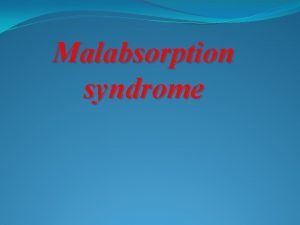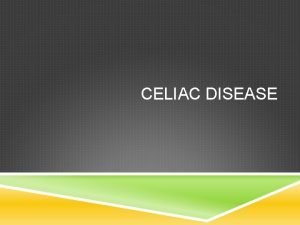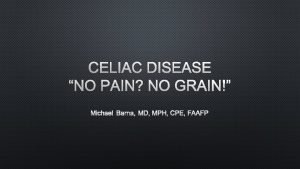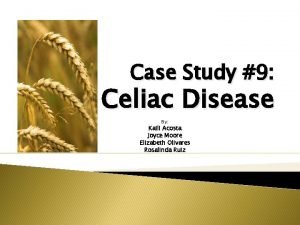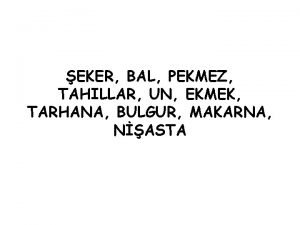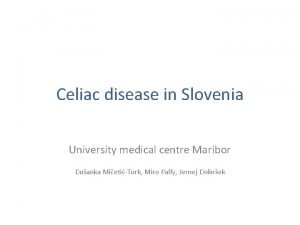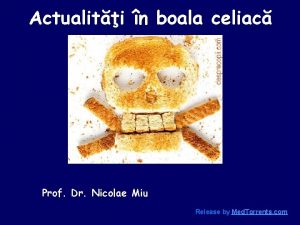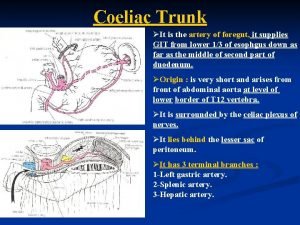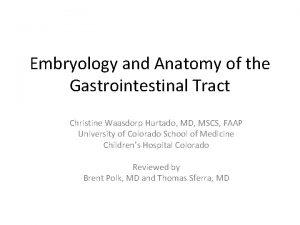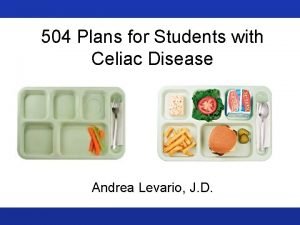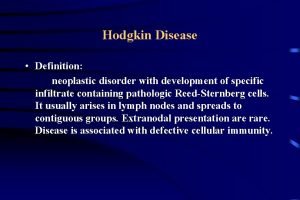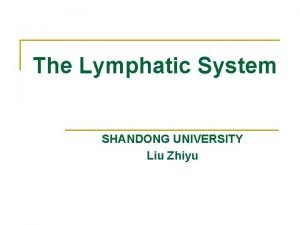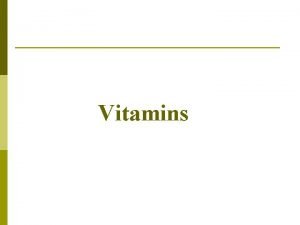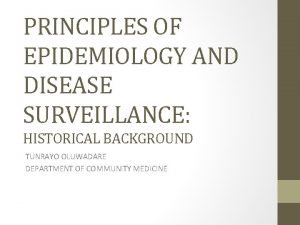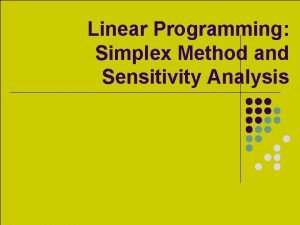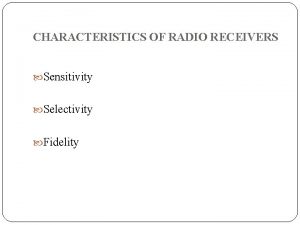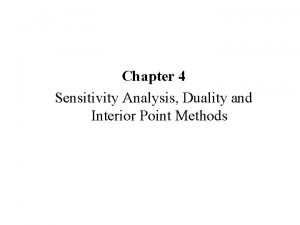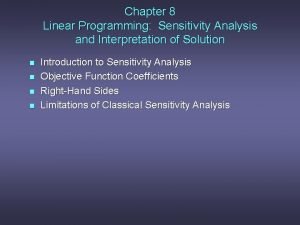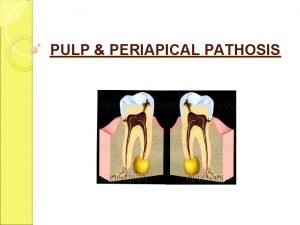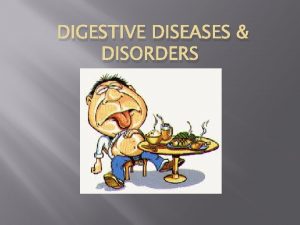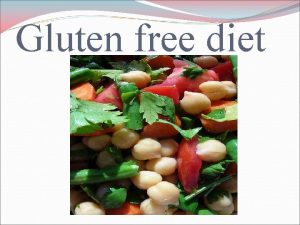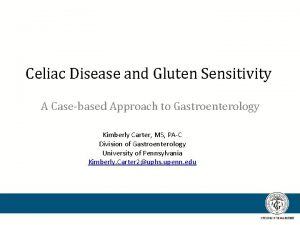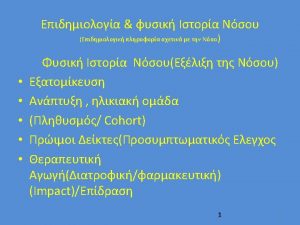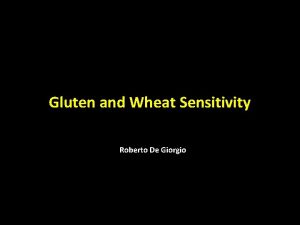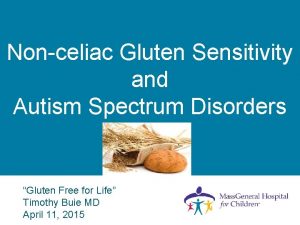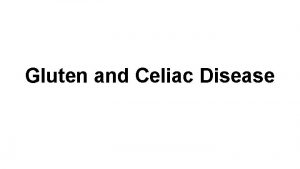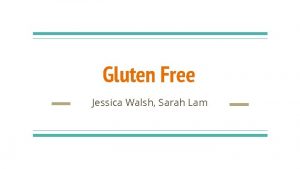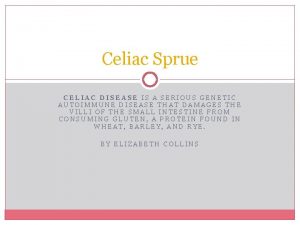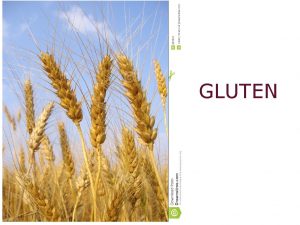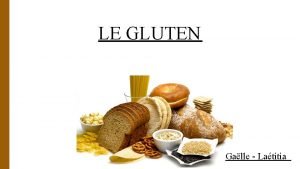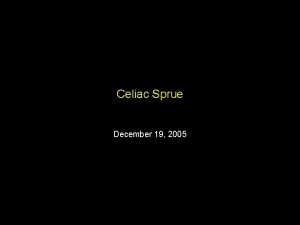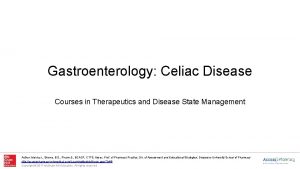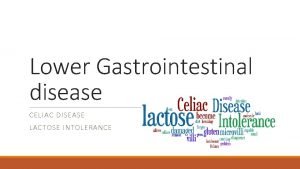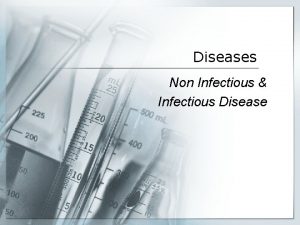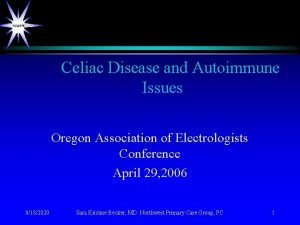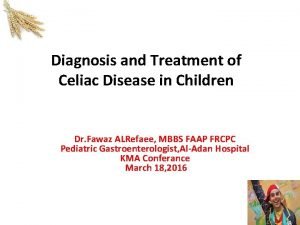Celiac Disease and Gluten Sensitivity The Diseases the

















































- Slides: 49

Celiac Disease and Gluten Sensitivity The Diseases, the Diet and the Legislation Volunteer Training© (Web version) revised May 2013 Developed and presented by CCA Calgary Chapter

Topics for Today • The Medical Conditions - Celiac Disease, including Dermatitis Herpetiformis and Non Celiac Gluten Sensitivity • The Gluten-Free Diet and the Cereal Grains • Legislative Regulations • Product Contamination

The Diseases Celiac Disease including Dermatitis Herpetiformis and Non Celiac Gluten Sensitivity

Celiac Disease - Genetic Properties • Celiac Disease (CD) is a true autoimmune disease. • The genetic predisposition (HLA), the environmental trigger (Gluten) and the inflammatory response (t. TG) are all known. • CD is currently the only autoimmune disease for which all three factors are known. • Celiac Disease is the most common autoimmune disease recognized in the medical community. (~1% of the population)

The Process of Disease Damage • Genes determine the risk for developing CD. (HLA DQ 2, HLA DQ 8) • Gluten triggers the abnormal immune response. • The intestinal villi become damaged. • Nutrients, including carbohydrates, proteins, fats, vitamins and minerals, can no longer be absorbed. • This leads to malnutrition and other serious health problems. • Intestinal permeability increases. (Leaky Gut) • There is a systemic response.

The Nature of Celiac Disease • CD was formerly thought to be a disease of childhood. • It is now recognized as a disease that can occur at any age. • CD can be triggered in otherwise healthy, genetically predisposed people when additional stresses are placed on the body, including: childbirth, severe infections, surgery, food poisoning and emotional stress… • It can present with a multitude of different symptoms.

The Nature of Celiac Disease It was once thought that CD had classic symptoms only, including: • • • Abdominal cramping and pain Nausea and/or vomiting Intestinal gas and bloating Diarrhea, including steatorrhea Weight loss Anemia and vitamin deficiencies – iron, folate, B 12, A, D, E, K

The Nature of Celiac Disease It is now recognized as a multi-system disease including additional intestinal symptoms: • Weight gain • Constipation • Lactose intolerance • Mouth ulcers (canker sores) And non-intestinal symptoms: • Easy bruising of the skin • Edema of the hands and ankles • Bone and joint pain, including arthritis • Osteoporosis • Fertility problems, amenorrhea, impotence • Depression • Nervous system disorders – central and peripheral • Extreme weakness and fatigue

The Nature of Celiac Disease There additional symptoms in children, including: • • • Dental enamel defects Delayed puberty Failure to thrive/delayed growth/short stature Abdominal distension Learning difficulties Severe irritability/behavioural changes

The Nature of Celiac Disease CD is often associated with some other diseases and conditions, including: • • Type 1 diabetes Autoimmune thyroid disease Liver enzymes elevations Autoimmune hepatitis Intestinal lymphoma Ig. A deficiency Addison’s disease Down syndrome, Turner’s syndrome, Williams syndrome And less commonly: • Sjogren’s disease • Systemic lupus erythematosus • Epilepsy • Sarcoidosis

Frequency of Occurrence Celiac Disease occurs in ~1% of the population. It occurs more frequently in immediate family members: • 8 – 15% of first degree relatives. (Parents, Children, Siblings) • 5% of second degree relatives. (Grandparents, Grandchildren, Aunts, Uncles)

What Happens When We’re Glutened? The progression of damage to the villi

Dermatitis Herpetiformis • Dermatitis Herpetiformis (DH) is an intensely itchy skin rash. • It is a form of celiac disease and is often referred to as CD of the skin. • People diagnosed with DH will also have intestinal damage, with or without symptoms. • The rash symptoms are often treated with dapsone in addition to the GF diet. • The mechanism for developing DH is through the ingestion of gluten.

What Happens When We’re Glutened? DH on the elbow DH on the knee

Diagnosing Celiac Disease • A series of serologic (blood) tests can assist in the preliminary screening for CD. • Serum Ig. A-tissue transglutaminase testing (Ig. A-t. TG) OR/AND • Serum Ig. A-endomesial antibody testing (Ig. A-EMA) PLUS • Total serum Ig. A In Calgary, the standard lab requisition has a Celiac Screen request for these specific tests. • An intestinal biopsy must be performed to confirm the diagnosis of CD.

Treatment of CD The only treatment for Celiac Disease is a STRICT GLUTEN-FREE DIET FOR LIFE. The GF Diet should not be started without an accurate biopsy diagnosis of Celiac Disease.

What Happens When We’re Glutened? • Even small amounts of gluten can be harmful to people with celiac disease and can cause continued small bowel damage. (With or without apparent symptoms) ******* • The accidental ingestion of gluten does not cause the profound anaphylactic response that is common with peanuts and other allergens.

What Happens When We’re Glutened? • Many people with CD will have immediate intestinal symptoms. • Many will have delayed intestinal symptoms. • Many will have non-intestinal symptoms. Immediate or delayed • Many will have no symptoms but will still have intestinal damage which can lead to other illnesses. • The amount of gluten that causes symptoms varies greatly amidst individuals, with some being extremely sensitive.

Gluten Sensitivity • Scientific research now supports the existence of this distinct condition and that many people can be gluten sensitive without having biopsy proven celiac disease. • This research also indicates that Gluten Sensitivity affects ~10% of the general population. Fasano 6%, Ford 30% • The symptoms of Gluten Sensitivity are similar to CD symptoms. • There are currently no reliable tests to diagnose Gluten Sensitivity. • This condition is referred to as Non-Celiac Gluten Sensitivity (NCGS).

The Gluten-Free Diet and The Cereal Grains

The Cereal Grains

Gluten Containing Grains & Grain Products Grasses, Grains, Cereals Wheat including Bulgur Emmer Spelt(Dinkel) Barley Oats* Durum Farro Einkorn Kamut Rye Triticale ______________________________________ _ Cereal Binding Graham flour** Semolina Couscous Malt * Included in the Canadian Gluten-Free Regulation ** Not to be confused with Gram flour Filler Roux

Gluten-Free Grains & Grain Substitutes Corn (Maize) Rice Sorghum ______________________________________ _ Amaranth Cassava Flax Nuts Potatoes Soy Wild Rice Arrowroot* Coconut Legumes Poi Quinoa Tapioca Buckwheat Dahl (Gram)** Millet Polenta Sago Teff ______________________________________ _ Montina® (Indian Rice Grass) * A GF Flour not to be confused with ‘Arrowroot Cookies’ ** Not to be confused with Graham flour Timtana® (Timothy)

Other Gluten-free Foods • Fresh meat, poultry, fish and seafood (unseasoned) • Fresh vegetables and fruits (including fresh frozen) • Eggs • Nuts and seeds • Legumes • Cheese and other dairy – lactose intolerance vs milk protein allergy (Lactose intolerance is often associated with Celiac Disease) • All products made with gluten-free ingredients

Questionable Products Baking powder Bouillon cubes Condiments Dry roasted nuts Herbal teas Ice cream and yogurt Imitation seafood Marinades and sauces Pilaf mixes Puddings Salad dressing Seasoned fries Smarties** Soy sauce Beverage mixes Cheese spreads Dried fruit *Flavourings HPP/HVP Icing sugar products Licorice and candies Modified food starch Processed meats Rice and soy beverages *Seasonings Self basting poultry Soups and broths Worcestershire sauce * The new allergy labelling will clearly include all gluten sources. Remember to review all product labels. Seasonings and flavourings are often overlooked. ** Some alternate M&M products do not contain gluten.

Quick and Easy References

Using Safe Alternatives • Many common food products have safe alternatives: Eg. Soy sauce. • Safe thickening agents can be used in place of flour: Eg. Potato starch, tapioca starch • Many food items have gluten-free alternatives: Pizza shells, pasta Eg:

Domestic vs. Commercial Products Many products marketed in regular grocery stores contain different ingredients than their commercial counterparts marketed to restaurants and other high volume commercial facilities. Examples include: Worcestershire sauces, salad dressings, marinades, bouillon bases, pilaf seasonings, flavourings… Check with restaurant staff (and staff of other facilities) and review labels carefully to assure safety of ingredients.

Thoughts to Consider Thoughts to keep in mind about gluten free choices: • Manufacturers do not commonly fortify milled GF grains with essential nutrients including vitamins and minerals. (This appears to be changing) • Many gluten free grains and grain substitutes are more calorie dense than gluten containing flours. • Many gluten free baked goods use more fats, oils, sugar and eggs to prevent crumbling of the products. Consult a Registered Dietitian to determine optimal nutritional intake on the Gluten Free Diet. (Include current lab results to review any nutrient deficiencies. )

Legislation and Labelling

Major Concerns • Product Labelling • • Safe and Unsafe Ingredients Hidden Sources of Gluten* Ambiguous Ingredients* Ambiguous Labeling* • *With the newly revised allergy legislation, these concerns have been resolved. (with a few exceptions). • Contamination and Cross-Contamination • These continue to be of concern

What is Gluten ? • Gluten refers to several different cereal grain storage proteins, or prolamins. • Gliadin in wheat • Secalin in rye • Hordein in barley There is ongoing confusion over references to glutinous rice and corn gluten (Avena is the protein found in Oats)

The New Allergy Regulation The new Allergy Regulation came into effect 4 Aug 2012… In addition to the declaration of the top allergens, …The gluten source must be declared when a food contains gluten protein or modified gluten protein from barley, oats, rye, triticale or wheat, including kamut or spelt… and must be written in plain language. • Information about gluten content can be found in: • The INGREDIENT list • The WARNINGS section – CONTAINS, MAY CONTAIN. (The ‘may contain’ statement is a voluntary statement. ) The Allergy Regulation pertains to food ingredients

The New Gluten-Free Regulation Revisions to the Gluten-Free Regulation also came into effect on 4 Aug 2012… • It is prohibited to label, package, sell or advertise a food in a manner likely to create an impression that it is a gluten-free food if the food contains any gluten protein or modified gluten protein, including any gluten protein fraction, referred to in the definition "gluten" in subsection B. 010. 1(1). • Subsection B. 010. 1(1) reads: "gluten“ (a) any gluten protein from the grain of any of the following cereals or the grain of a hybridized strain created from at least one of the following cereals: (i) barley, (ii) oats, (iii) rye, (iv) triticale, or (v) wheat, kamut or spelt; or (b) any modified gluten protein, including any gluten protein fraction, that is derived from the grain of any of the cereals referred to in subparagraphs (a)(i) to (v) or the grain of a hybridized strain referred to in paragraph (a). (gluten)

The New Gluten-Free Regulation Also included in the gluten free regulation… Based on available scientific evidence, Health Canada considers that gluten-free foods prepared under good manufacturing practices, which contain levels of gluten not exceeding 20 ppm as a result of crosscontamination, meet the health and safety intent of the gluten-free regulation (B. 24. 018) when a gluten-free claim is made… The Gluten-Free Regulation pertains to cross-contamination of gluten-free ingredients.

20 parts per million ½ tsp. Half a teaspoon In a bathtub filled with water (125 litre bathtub)

20 parts per million Less than a drop In 2 litres of ice cream (1 drop in 2. 5 litres)

20 ppm in Daily Living Based on the gluten-free regulation (<20 ppm), scientific evidence and the usual eating practices of people on a gluten free diet consuming 250 – 400 grams of GF foods daily, the average person with Celiac Disease could safely consume up to 10 mg of gluten daily without adverse effects. Based on this evidence, less than a teaspoon of pure gluten, (equivalent to 3500 mg), would be the maximum tolerable amount for an entire year.

10 milligrams daily • Less than one teaspoon of gluten • Equivalent to one sugar sweetener for your coffee (3. 5 gr) • Is the maximum amount considered safe in a year

Preventing Contamination and Cross. Contamination In food service industries and facilities. • • • Restaurants and banquet halls Seniors’ facilities Day care centres School classrooms, lunchrooms and cafeterias… Other locations

Preventing Contamination & Cross-contamination • When preparing a gluten-free meal, it is important to prevent contamination of the gluten -free foods with gluten-containing food particles and residues. • Even small amounts of gluten can result in continued intestinal damage for people with CD and DH • Care must be taken to ensure that glutenfree foods remain gluten-free.

Preventing Contamination & Cross-contamination • Select a preparation area that is separate from other food preparation areas. • Air-borne flour and other gluten-containing particles can contaminate gluten-free foods. • Ensure all preparation surfaces, cooking surfaces and cooking utensils have been thoroughly cleaned, including counter top, meat slicer, grill surface, cutting boards, bowls, knives, utensils, thermometers, cleaning cloths, aprons.

Preventing Contamination & Cross-contamination • Use dedicated pots, pans, utensils and cutting boards whenever possible. • Rolled edge pans are easier to clean. Scrub with soap and water to ensure removal of gluten-containing particle. Disinfect according to current standards of practice.

Preventing Contamination & Cross-contamination • Follow impeccable hand washing practices. • Use sanitary gloves for food preparation and change them before handling GF foods. • Ensure the powder used is gluten-free. Even powder-free gloves can have trace amounts of powder. • Become knowledgeable about special needs diets and menu selections. Educational programs are offered through many of the local chapters of the Canadian Celiac Association.

Preventing Contamination & Cross-contamination • Ensure all ingredients are gluten-free. • Check product ingredients regularly. Manufacturers and suppliers can change ingredients without notice. • Ensure that anti-caking and flow agents are GF. These agents may not be identified in the ingredient lists. * • Use boldly labeled, air tight containers for all products designated as GF. • Prepare GF meals before other menu selections * the new allergy labeling requires these agents to be declared.

Preventing Contamination & Cross-contamination • Clean utensils must be used for each condiment, butter, sauce and all other items. • Use individual portions and/or squeeze bottles. • Deep fryer oil previously used for glutencontaining foods is unsafe for gluten-free cooking. (Particles and residues) • Fresh water must always be used for boiling, poaching or steaming.

Preventing Contamination & Cross-contamination • Use the top oven racks and refrigerator shelves. • Use caution with convection ovens. • Use toaster bags to prevent contamination of GF bread products. (Check with the Calgary office for availability. ) • Bulk bins can be a source for crosscontamination.

Using Safe Alternatives • Many foods start out gluten-free and are glutened in menu preparation: Eg. Salad croutons • Develop clearly identified gluten-free alternatives as part of a standard menu. • Arrange buffet tables with gluten-free selections first and separated from gluten-containing selections. Label them.

Reliable Websites Canadian Celiac Association http: //www. celiac. ca Calgary Chapter (Dr. Decker Butzner, Dr. Paul Beck) http: //www. calgaryceliac. ca University of Maryland (Dr. Alessio Fasano) http: //www. celiaccenter. org Mayo Clinic (Dr. Joe Murray) http: //www. mayoclinic. com/health/celiac-disease/ Columbia University (Dr. Peter Green) http: //www. celiacdiseasecenter. columbia. edu The Gluten Free Diet – Shelley Case, RD www. glutenfreediet. ca
 Prof dr tufan kutlu
Prof dr tufan kutlu Disaccharidase deficiency celiac disease
Disaccharidase deficiency celiac disease Celiac disease in french
Celiac disease in french Celiac disease pes statement
Celiac disease pes statement Marsh classification of celiac disease
Marsh classification of celiac disease Celiac disease pes statement
Celiac disease pes statement Celiac disease pes statement
Celiac disease pes statement Celiac disease colville
Celiac disease colville Lentils examples
Lentils examples Gluten kompleksi nasıl oluşur
Gluten kompleksi nasıl oluşur Augustus gluten
Augustus gluten Dogs and cats by bob brady genre
Dogs and cats by bob brady genre Gluten development in quick breads
Gluten development in quick breads Slowenien university medical center
Slowenien university medical center Boala celiaca definitie
Boala celiaca definitie Communicable disease and non communicable disease
Communicable disease and non communicable disease Superior mesenteric artery origin
Superior mesenteric artery origin Celiac ganglion
Celiac ganglion Superior rectal artery is a branch of
Superior rectal artery is a branch of Branches of celiac trunk
Branches of celiac trunk Acid secretion
Acid secretion Great saphenous vein
Great saphenous vein Celiac 504 plan
Celiac 504 plan External illiac artery
External illiac artery Celiac disesae
Celiac disesae Lymph composition
Lymph composition Vitamins are organic compounds that
Vitamins are organic compounds that John snow epidemiology
John snow epidemiology Prometheus celiac serology
Prometheus celiac serology Sensitivity analysis linear programming
Sensitivity analysis linear programming Selectivity in analog communication
Selectivity in analog communication Sensitivity analysis and duality
Sensitivity analysis and duality Range of feasibility
Range of feasibility Lifestyle modern
Lifestyle modern Communicable and noncommunicable diseases venn diagram
Communicable and noncommunicable diseases venn diagram Section 19-3 diseases caused by bacteria and viruses
Section 19-3 diseases caused by bacteria and viruses Retention hyperkeratosis dermnet
Retention hyperkeratosis dermnet Chapter 6 musculoskeletal system diseases and disorders
Chapter 6 musculoskeletal system diseases and disorders Chapter 24 sexually transmitted diseases and hiv/aids
Chapter 24 sexually transmitted diseases and hiv/aids Chapter 22 genetics and genetically linked diseases
Chapter 22 genetics and genetically linked diseases Chapter 21 mental health diseases and disorders
Chapter 21 mental health diseases and disorders Chapter 17 reproductive system diseases and disorders
Chapter 17 reproductive system diseases and disorders Chapter 15 nervous system diseases and disorders
Chapter 15 nervous system diseases and disorders Nail diseases and disorders milady
Nail diseases and disorders milady Seborrheic keratoses
Seborrheic keratoses In what situation should a nail service not be performed?
In what situation should a nail service not be performed? Certain infectious and parasitic diseases
Certain infectious and parasitic diseases Chapter 8 cardiovascular system
Chapter 8 cardiovascular system Chronic pulpitis
Chronic pulpitis Milady chapter 8 skin disorders and diseases
Milady chapter 8 skin disorders and diseases

